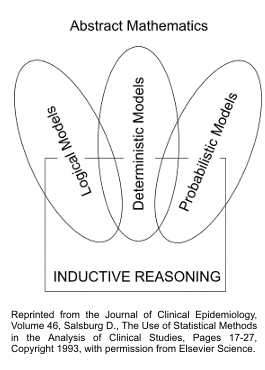|
|
Conceptual Basis of the Taxonomy
 Qualitative/Personal
Qualitative/Personal
Evidence is primarily narrative in nature, emerges from a historical context, and is concerned with meaning and particular individuals. It involves the varying beliefs, attitudes, preferences, predispositions, perceptions and "epistemological frames" brought forth by both health care provider and patient.
Qualitative/General
Evidence is primarily social and historical, illustrates social views and preferences and is manifest in policy debates and consensus statements. Here, the managerial perspective emerges as does the set of sciences devoted to the study of health care in its organizational manifestations. The cultural, social and gender dimensions of evidence emerge more prominently in this quadrant.
Quantitative/General
Evidence is primarily statistical in nature and general in its application. Measurement and rigor are the chief concerns. Quantitative data derived through the application of recognized study designs constitute the basis of evidence. It is impersonal in the sense that the evidence is intended to be general in application and not subject to bias or self or group interest.
Quantitative/Personal
Evidence is primarily mathematical and personal. Research exemplars include some elements of clinical epidemiology, quality of life scales and cognitive psychology. Evidence is defined in terms of measurement of personal belief. The most clearly stated and developed manifestation of this is found in the development of Bayesian methods of reasoning.
Click
here for examples of the evidence taxonomy quadrants
| Back to Top |
Locating Evidence
Scientific
evidence related to health care can be situated or exemplified in relation
to concepts of epistemology, the philosophy of science and logic. There
is a good justification for using these frameworks to help us understand
evidence.
What is Epistemology?
Epistemology is the branch of philosophy devoted to researching questions about the nature, scope and justification of human knowledge. More specifically epistemology asks questions about the nature of human beliefs, scientific and otherwise, and explores issues in the adequacy of reasons put forth to justify those beliefs.
We have seen in the definition and characterization of evidence that there is a clear relationship between evidence and belief and the justification of belief. Thus there is a conceptual link between evidence and epistemology. Other disciplines, most notably sociology of science, also look at these relationships. However, in philosophy the varieties of possible ways of construing knowledge have been well worked out and include sociological, legal and scientific perspectives.
Knowledge and Evidence
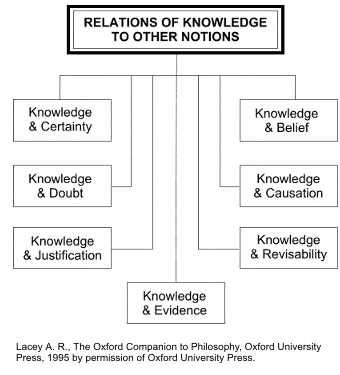 What
is the relationship between knowledge and evidence?
What
is the relationship between knowledge and evidence?
Knowledge can be defined as the set of propositions about any subject regarded as true. Modern scientific knowledge is quite complex and sophisticated. There is a lot of knowledge that is discipline specific. Discipline specificity is exemplified by the employment of unique vocabulary, technology, and patterns of practice. In health care these propositions would take a variety of different forms depending on the context in which the claim for knowledge was being made.
It is unclear whether evidence is distinct from or synonymous with knowledge in the EBM debate. The terms are often used interchangeably, though in philosophy they are kept distinct. It is likely important to keep the concepts apart, as will be seen when the relationship of evidence to reasoning is considered in greater detail.
The following example will help to illustrate the distinction. Imagine a physician and patient discussing whether or not a certain medication will be effective in lowering blood pressure. The physician states that she knows that hydrochlorothiazide will lower the patients blood pressure. The patient responds " How do you know?". Consider the range of possible answers available to the physician:
- Because I'm a doctor (Intuition/Authority)
- Because in my experience it works (Experience)
- Because it interferes with a specific biochemical process that will lower blood pressure (Basic Science)
- Because many well designed studies have shown that the drug is effective in lowering blood pressure (Clinical Science)
| Back to Top |
Science has both theoretical and practical aims. Scientific evidence in health care operates at an intersection of both the theoretical and practical aims of science. The theoretical and practical aims of science can be broadly conceived as:
- Establishing true propositions about the natural world
- Providing a coherent account of natural processes
- Providing explanations of phenomena that link observations to theories
- Providing the justification for actions
- Allowing
for accurate predictions of future states of affairs
Scientific evidence in health care is largely practical in intent. It is intended to improve decisions and therefore outcomes in the health status of those upon whom evidence based medicine is practiced.
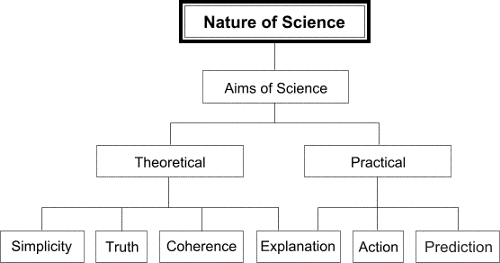 |
| Lacey A. R., The Oxford Companion to Philosophy, Oxford University Press, 1995 by permission of Oxford University Press. |
| Back to Top |
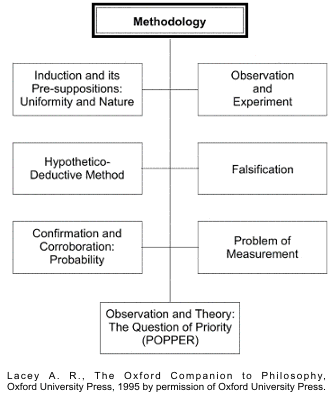 Methodology
is the manner by which observations are recorded and organized. In science,
method is of crucial importance, it is meant to be explicit, systematic,
and logical. From the adjacent diagram, it is clear that there is a great
deal of complexity involved in scientific methodology. Method, theory,
inference are intimately interwoven.
Methodology
is the manner by which observations are recorded and organized. In science,
method is of crucial importance, it is meant to be explicit, systematic,
and logical. From the adjacent diagram, it is clear that there is a great
deal of complexity involved in scientific methodology. Method, theory,
inference are intimately interwoven.
The diagram helps us to locate the role of methodology in the creation of evidence in health care. In health care a wide range of designs are employed to generate evidence. Broadly speaking, they fall into two general categories: observational and experimental.
In experimental methodologies, variables are under the control of the investigator and are manipulated through the employment of randomization. Examples of experimental designs are randomized controlled trials, N-of-1 trials, and many basic science studies.
Observational studies can be quantitative or qualitative. In general, key variables are not under the control of the investigator. Quantitative observational study designs include cohort studies, case control studies and cross sectional surveys. Qualitative studies include interviews, document analysis, and focus groups.
Each
of these methods is designed to answer specific questions. Each has its
inherent strengths and limitations. Understanding the relationship between
evidence and methodology is crucial in order to properly interpret the
results of a study.
For
an excellent step by step account of a quantitative study please go to
On-line
Training in Clinical Research with CORDS.
For
an account of qualitative study designs, please go to Qualitative
Research in Health Care.
| Back to Top |
| Back to Top |
Probabilistic
Models Further Refined
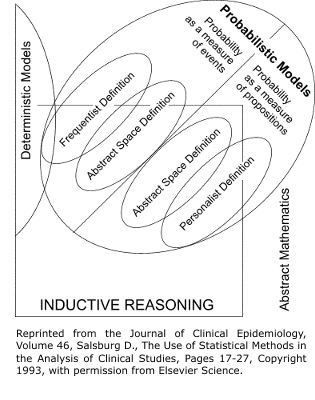 This
figure, also from David Salsburg, shows us how probabilistic models can
be refined. Probability is a familiar concept to most people. We commonly
use probability estimates in every day life and are surrounded by probabilistic
reasoning in the media. A good example from daily life is the probability
of precipitation found in weather forecasts.
This
figure, also from David Salsburg, shows us how probabilistic models can
be refined. Probability is a familiar concept to most people. We commonly
use probability estimates in every day life and are surrounded by probabilistic
reasoning in the media. A good example from daily life is the probability
of precipitation found in weather forecasts.
However, there is not agreement among statistical theorists about what a probability is. To one school of thought, a probability is an objective property of events in the natural world. This is often referred to as the frequentist position. To the other major school of thought, a probability reflects a measure of belief. That is a probability is a subjective property.
The taxonomy approaches the issue of the meaning of probability by recognizing both definitions. It has been shown in research studies that medical professionals tend to interpret probabilities subjectively.
| Back to Top |
